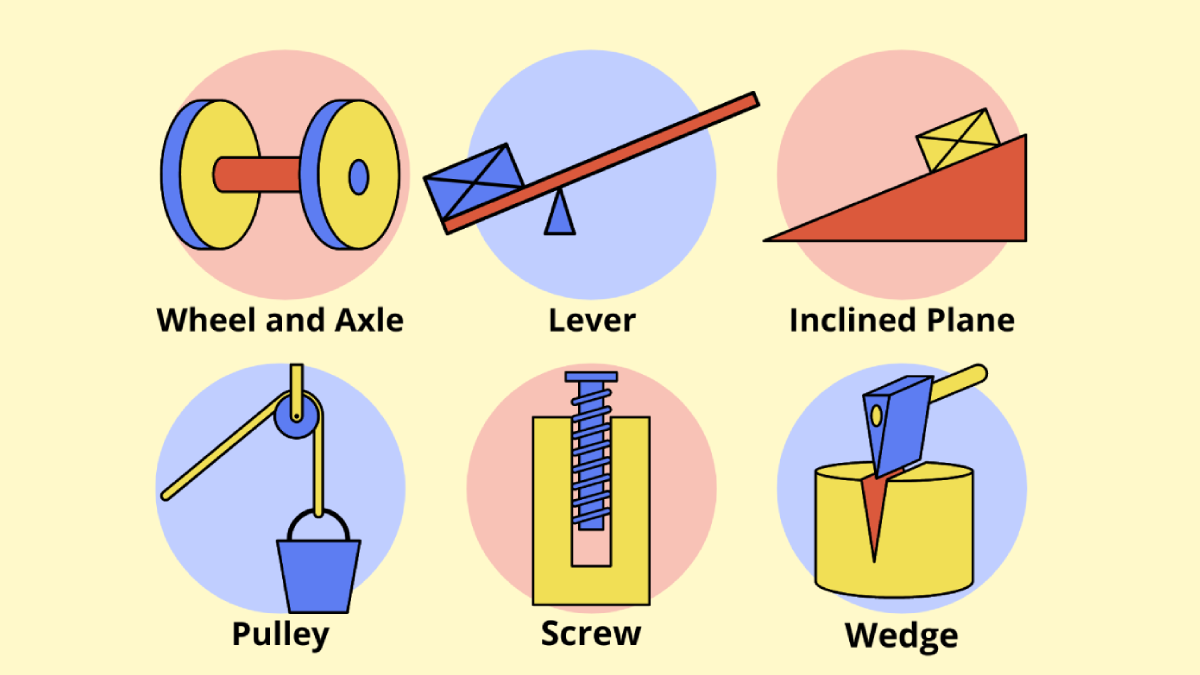The Simple Machines Activity is a fun and interactive that introduces participants to the six types of simple machines: lever, pulley, inclined plane, wedge, screw, and wheel and axle. This activity allows participants to explore how simple machines make work easier by reducing the effort required to perform tasks. Below is a step-by-step guide for conducting the Simple Machines Activity:
Materials Needed:
- Various household objects or toy models representing each type of simple machine (for example, a seesaw for a lever, a pulley system, a ramp for an inclined plane, a doorstop for a wedge, a screwdriver for a screw, and a rolling pin for a wheel and axle).
- Optional: Building materials (for example, craft sticks, cardboard, tape, string) for participants to create their simple machines.
Instructions:
- Introduction: Begin by introducing the concept of simple machines and their role in everyday life. Explain that simple machines are tools that make tasks easier by requiring less force to accomplish a specific job.
- Types of Simple Machines: Present the six types of simple machines one by one and demonstrate how each works. You can use the household objects or toy models to show real-life examples and how they operate.
- Hands-On Exploration: After introducing each type of simple machine, allow participants to explore and interact with the objects or models. Encourage them to manipulate the simple machines and observe how they function.
- Identify Simple Machines: As participants explore, ask them to identify which simple machine each object or model represents. Discuss how each machine helps to perform a particular task more efficiently.
- Build Your Own Simple Machines (Optional): For more hands-on engagement, provide participants with building materials and challenge them to create their simple machines. For example, they could design and build a mini catapult (lever), a zip line (pulley), or a marble ramp (inclined plane).
- Problem-Solving and Design: Encourage participants to think about how they can modify their creations to make them more effective or solve specific tasks.
- Simple Machines Game: Create a game or challenge where participants have to use simple machines to complete different tasks. For example, they could use a lever to lift a weighted object or use a pulley to move an item from one place to another.
- Reflect and Discuss: Gather participants for a group discussion. Ask them about their experiences exploring and building simple machines. Discuss the advantages of using simple machines in various situations.
- Real-World Applications: Conclude the activity by discussing real-world applications of simple machines, such as in construction, transportation, and everyday devices.
- Extension Activities: For older participants or those interested in more complex challenges, explore compound machines, which combine multiple simple machines to perform more advanced tasks.
The Simple Machines Activity introduces participants to basic engineering principles while fostering creativity and problem-solving skills. It encourages hands-on learning and provides opportunities for discussions on the practical applications of simple machines in everyday life.
| STEM Concept | Explanation and Application |
| Science Concepts | |
| Mechanics | Understanding the principles of how forces and motion interact in the operation of simple machines. |
| Mechanical Advantage | Exploring how simple machines provide a mechanical advantage, reducing the effort needed to perform tasks. |
| Technology Concepts | |
| Mechanisms | Identifying the mechanisms and components that make up each type of simple machine and how they function. |
| Tools and Instruments | Introducing various tools and instruments used to build and operate simple machines. |
| Engineering Concepts | |
| Design and Construction | Applying design principles to create and modify simple machines or build new ones using building materials. |
| Problem-solving | Encouraging problem-solving skills as participants experiment and adjust their simple machines for efficiency. |
| Mathematics Concepts | |
| Measurement | Measuring and comparing forces, distances, and dimensions involved in the operation of simple machines. |
| Ratios and Proportions | Understanding the relationship between input force and output force, considering mechanical advantage. |
| Geometry and Angles | |
| Inclined Planes | Exploring the geometry and angles of inclined planes and ramps and how they affect the effort needed to move objects. |
| Rotational Motion | Investigating the rotational motion of wheels and axles, gears, and other rotary components in simple machines. |
Simple Machines Activity. Each concept can be further explored and expanded based on the age, understanding, and grade level of the participants. Additionally, this activity can be a starting point for exploring more complex STEM topics related to mechanics, engineering design, and advanced mathematics concepts as participants deepen their understanding of simple machines and their applications. The activity provides a solid foundation for future learning in science, technology, engineering, and mathematics fields.

